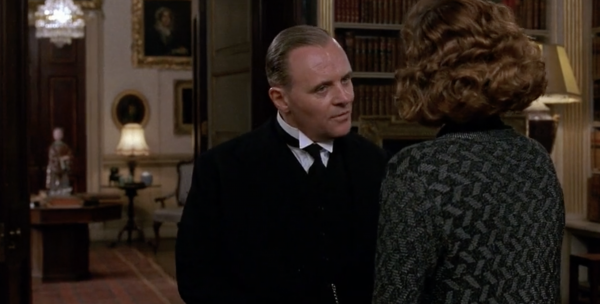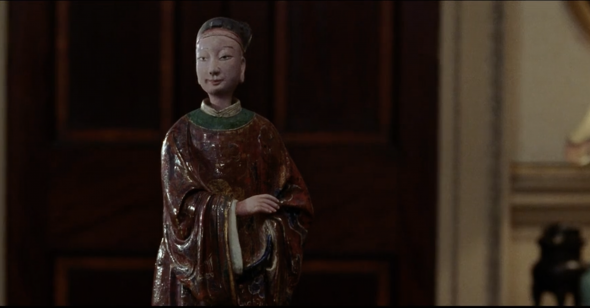A Slight Nod
Michael Koresky on The Remains of the Day
“Is that or is it not the wrong Chinaman?” A strange phrase, especially one to be so vehemently uttered in the punctilious world of Darlington Hall. Nevertheless, housekeeper Miss Kenton (Emma Thompson) relentlessly pursues the grand English manor’s head butler Mr. Stevens (Anthony Hopkins) through its effortfully kept-up drawing rooms and libraries to get him to answer her query. What she’s referring to has meaning. But it’s the kind of meaning that moves beyond mere plot or motivation; it’s a small scene—and it’s a small object—yet it’s freighted with import, reflecting The Remains of the Day’s emotional, historical, racial, socioeconomic, even perceptual contours.
The object in question—rudely, curtly, oddly called the “Chinaman”—is something the film’s main character, Mr. Stevens, is being directed to look at, as is, therefore, the viewer. “Look at it!” Miss Kenton exclaims, pointing a finger at the space beyond the camera and, in this shot-reverse shot setup, behind where Mr. Stevens is standing. This confrontation has been going on for some time, and he has been refusing to look or to indulge in what he dismisses as a whim of hers. There are emotional reasons why he refuses to look. To look would be to acknowledge what he fears might be true: that his elderly father, whom he had recently hired as his underbutler, has confused two objects in the house, mistaking a pair of (one presumes) imported Chinese statues, and putting the “wrong Chinaman” in the wrong room. This is, Miss Kenton insists, in keeping with a series of errors done by the elder Mr. Stevens, including noticeably leaving polish on the cutlery and forgetting to pick up a dustpan from the staircase. For Mr. Stevens to accept these mistakes is to properly bear witness to the deterioration of not only his father but also a once-great manservant, a legendary one even, and considering Mr. Stevens’s obsession with his work, this might be the greater tragedy.
This brief description of plot and character psychology cannot begin to describe the strange centrality and purpose of the “wrong Chinaman,” an object which merits just three pages of handwringing in Kazuo Ishiguro’s source novel and which appears for all of three seconds of screen time in James Ivory and Ismail Merchant’s 1993 film adaptation. In both book and film, the “Chinaman” is incidental, symbolic, a representation of a character’s failing abilities and a way of life passing into irrelevance, in this case the British aristocracy in the days leading up to the Second World War. It’s a film that exists in the lineage of such works as Orson Welles’s The Magnificent Ambersons and Satyajit Ray’s The Music Room, all charting the waning days of an outmoded decadence that’s somehow lingered into the twentieth century, except that in this case it’s told from the perspective of underclass servants who so desperately and professionally helped to keep up their employer’s appearances.
Mr. Stevens, brilliantly realized by Ishiguro as a prideful, starkly unreliable first-person narrator, and wondrously interpreted by Hopkins as a walking, talking manifestation of deluded, servile repression, is a cagey embodiment of European aristocracy, as one who by virtue of caste and subordinacy cannot fully partake of the riches and benefits of wealth but is all too willing to espouse the merits of his highly dubious employer, Lord Darlington. He gives everything, asks for nothing in return, bears witness to evil, while concerning himself with nothing more relevant than the ironing of the morning newspaper or the refilling of a soup terrine. Mr. Stevens’s daily life is pointedly no more or less banal than the lives of the supposedly great men his labor supports, not least of all Darlington (played in the film by James Fox), whose cheerful naiveté and willful ignorance leads to his disgrace as a Hitler sympathizer.
Amidst the course of weighty human events that pass through Darlington Hall—the site of summits and dinners attended by both German and British politicians and aristocrats—the placement of the “wrong Chinaman” might barely register. Yet Ivory makes sure that we can’t look past it, even in its brief appearance. “Turn around and look at the Chinaman,” Miss Kenton says, finally, trying to keep her patience in check. She has been so insistent on getting him to look, and he has been so intransigent, that it has almost become a game, the first instance of an underlying eroticism that simmers between them and which will return intermittently throughout the film. Perhaps if she can get him to look at what she wants him to see, he will not just see the Chinaman, not just see his father’s mistake, but also he will, in essence, see her. At last, Mr. Stevens gives in and Hopkins swivels his entire body around in an effortlessly mechanical way, as though a button has been pushed and his human gears have been set in motion. The reverse shot of what he sees is destabilizing: here is the “Chinaman,” in medium close-up, yet entirely unexpectedly, its head is moving independently of its body, nodding and swiveling on its neck from left to right. This movement is accompanied by a glissando of chimes and a series of staccato horns from Richard Robbins’s score, giving the surprising motion a sense of magical otherworldliness. The statue’s expression is placidly smiling, almost taunting; the thing we and Mr. Stevens have been beseeched to look at is defiantly looking back at us.
Immediately, a viewer cannot help but wonder about the nature and derivation of this presumably imported object, a piece of “exotic” home furnishing that might feel alien if it hadn’t begat, centuries later, the “bobble-head” so common in novelty and tourist shops. The film does not go on to explain the history of Cantonese nodding-head figurines, though these were common imports to England, Continental Europe, and America starting in the late 18th century. Presumptively an object of exotic pride and great value to Lord Darlington, the nodding-head statue (which originated with Buddha figurines) functions as a remnant of the widespread appropriation of East Asian art that continued throughout the 19th and early 20th centuries, the traces of which still are felt in ornate Orientalist decoration. The visual pleasure of the nodding-head figurine, and its bobblehead-doll descendant, seems to lie in its incongruity, that something that should not be moving is defying its own principles, and that its freely moving head is working in gleeful defiance of its stock-still body—a playful articulation of the mind-body split. It doesn’t feel incidental that Miss Kenton is so forcibly trying to get Mr. Stevens—himself as still as a porcelain figurine—to look at something so inherently whimsical. Naturally, he immediately retreats from the vision, snapping back to reality and calling it a “trivial mistake” and therefore easily corrected. Yet the revelation of the nodding-head figure, and the way Robbins underscores it as a kind of talisman, gives it the sense of an opened Pandora’s box.
***
Coming from an Asian-born novelist (the Japanese-British Ishiguro was a child in Nagasaki and moved with his parents to Surrey in 1960), the use of the object and word “Chinaman” feel particularly weighted with purpose, and certainly from a writer who has made claims that his outsider nature has always allowed him to see his adopted country more clearly, as well as the respective hieratic cultures that formed him. The recurring use of the word “Chinaman” in both book and film becomes almost incantatory, and, for this one brief scene at least, lends Ishiguro’s story, originally published in 1989, an unavoidable post-colonial reading. Darlington Hall is a white world, one haunted by the specter of genocide (later, Lord Darlington will dismiss two Jewish refugee maids from service, all but certifying their being sent back to Germany immediately preceding the rise of the Third Reich). Remotely situated, and entirely cut off when not interfering directly in geopolitical matters its lord knows nothing about, Darlington Hall is cloistered, an Anglo-Saxon environment in which the presence of a “Chinaman,” particularly one not where it belongs, would likely be a significant intrusion.
Then there’s the matter of there being a “right” and a “wrong” Chinaman. It’s important to point out that in Ishiguro’s novel, there is no indication of what distinguishes one from the other. The author does provide a slight elaboration not stated in the film—that the Chinaman outside the billiard room has been incorrectly exchanged with the Chinaman on the upstairs landing—but their visual differences are left to the reader to imagine. It is an invention of the film that the “wrong” Chinaman is of the nodding-head variety. This figurine, with its head determinedly not on straight, seems to be a particular imposition to Miss Kenton and presumably anyone who might notice, which leads us to presume, though it’s never confirmed, that the film’s “right” Chinaman is a statue whose head stands still and straight. Yet this remains all a matter of perception, as well as interpretation. The object is thus tactile yet vaguely defined, and leads to a larger question: if the Chinaman doesn’t belong here, then what, or who, does? (Not a small question in a story about the dying days of a colonialist empire.)
The use of the nodding-head figure in Merchant-Ivory’s film points to essential industrial and aesthetic questions about adaptation. In interpreting another artist’s work, filmmakers not only must use their imaginations to realize moments, people, and things only fleetingly glanced at in the source text but also rely on an entire set of craftspeople to do so. In this way, production designer Luciana Arrighi must be considered the film’s author as much as Ivory, Merchant, Hopkins, Thompson, or Ishiguro, making a film as ornate and authentic as possible within a mid-range budget (it was estimated between 11 and 15 million). Like any film about our relationship to privilege and wealth, The Remains of the Day is inherently about objects, those we own, those we wield, those with which we serve, those we use to prop up our egos, those we use to hold our breakfast toast.
The “Chinaman”—whether right or wrong—is as significant, or as meaningless, as any of these, its meaning fluctuates depending on who’s in the room with it. Its value is unknown and variable, fitting for a film that begins in the post-war fifties at an auction of items from Darlington Hall, soon to be taken over by Mr. Lewis (Christopher Reeve), an American senator—and an amalgamation of two characters in Ishiguro’s novel—who had earlier criticized Lord Darlington for Nazi sympathizing. It’s his choice to decide which objects will be housed in this stately, if now tainted, English manor, and therefore, what value will be placed upon them.
The rare object to be used onscreen not simply as set dressing but as a crucial narrative turning point, the “Chinaman” also indicates how powerfully intertwined the pursuit of the creative imagination and the yearning for historical specificity are in our predominant mode of realist cinema: it indicates its own status as an object while nodding at its own impossibility. Through Robbins’s musical flourish, which greets it, and the inherent exoticism which with the western, Anglo world displays it, the statue is both magical and mundane, symbolic and entirely banal.
Partway through the film, we’re offered a glimpse of the “correct” Chinaman, quite literally in passing. Mr. Lewis is accompanying M. Dupont (Michel Lonsdale), a French politician he’s trying to dissuade from Darlington’s grasp, throughout the house, and as Mr. Stevens opens a parlor door to let them in, we see a different Chinese porcelain figurine in the frame’s foreground before Lewis and Dupont enter; the camera tracks right, and the scene cuts. You might notice that this “Chinaman” is wearing a green robe with red trimming, rather than the other’s red robe and green collar. You might notice that it looks slightly more polished and presentable. You might notice that its head isn’t bobbing. But you’d have to be looking.

